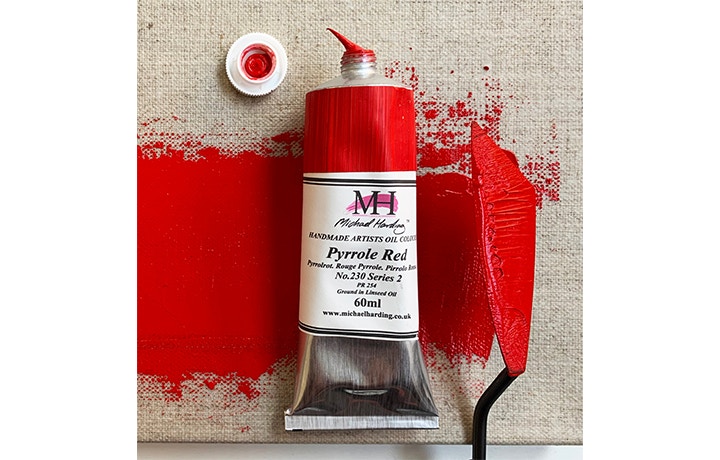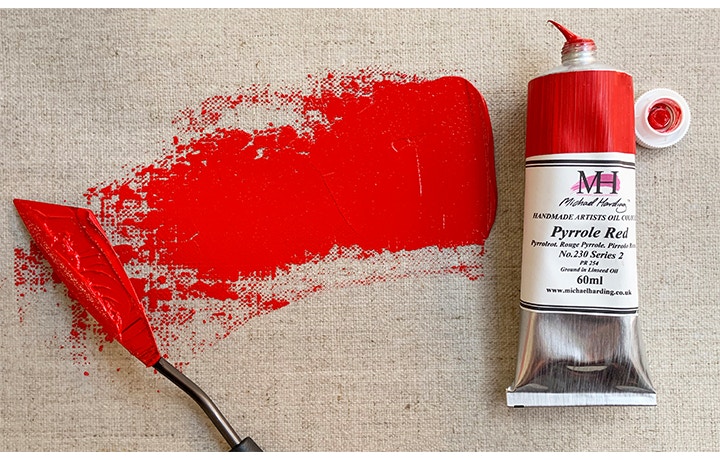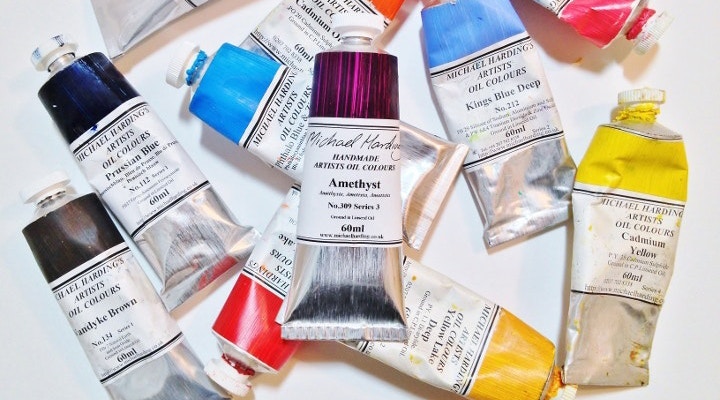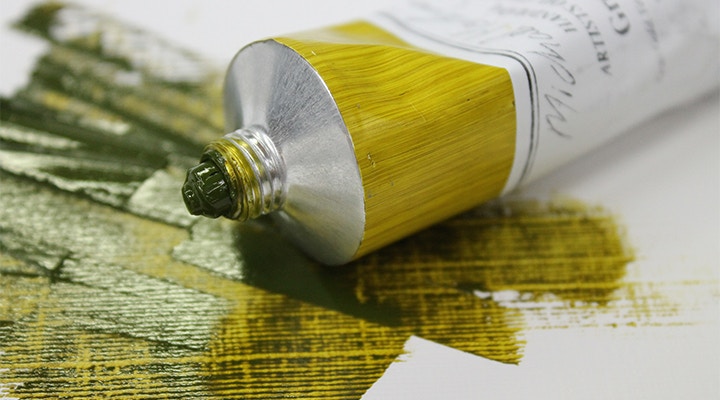Exclusive to Cass Art: Introducing Michael Harding Pyrrole Red
Posted by Cass Art on 24th Jul 2021
Over the years Michael Harding has brought us exceptionally beautiful pigments across a broad spectrum of colours. Manufacturing oil colour since 1982, each colour is handmade in the UK. He uses only the finest pigments, from Afghan Lapis Lazuli to real Chinese Vermilion, and is a celebrated favourite of artists worldwide, including David Hockney, Howard Hodgkin and Chris Ofili to name a few.
And this summer we're delighted to bring you Pyrrole Red - the latest colour added to Michael Harding's range of professional oil paints - launched exclusively here at Cass Art. Read on to find out more about this unique colour and for an exclusive interview with the man himself. Michael Harding is journey in creating world class oil colour and his ambition to develop the perfect consistency and aesthetic.

Michael Harding shares his motivation for creating this new shade: "I get immersed in vivid colours. I wanted to add an affordable red to my product line that compliments my currents reds and provides another level of depth in the family of MH reds. While my first passion is pigments from the period of our grand Old Masters time, today’s modern made pigments offer us yet another level of discovery and enjoyment. I feel Pyrrole Red is such a colour, an affordable, highly lightfast vivid red. My Pyrrole Red is like a lot of my oil product line, bold and bright yet with a cool, crisp undertone."
Technical Specification of Michael Harding Pyrrole Red:
Pigment Index Number Pr 254
____________________________________
Oil Content High
____________________________________
Opacity Covering Transparent
____________________________________
Drying Speed Average
____________________________________
Lightfastness Excellent

“If you think of paint as a two-part material, with the oil being the glue that binds the pigment particles into place, it is the pigment that is responsible for delivering the colour.” - Michael Harding
While humans have been making art, we’ve used pigments from unusual sources such as botanical materials, animal waste, insects and molluscs. All these unusual materials have been harvested and traded over long distances. Some colours were costly or impossible to mix with the range of pigments that were available and that's why blues and purples came to be associated with royalty - because they were just so expensive. For instance Tyrian Purple is a pigment made from the mucus of one of several species of Murex Snail. Michael Harding's oil paints are all handmade from organic materials.

Artist Ronan McGeough - Shares his thoughts about what makes Michael Harding paint so special
"Michael Harding would be my ‘go to’ in terms of oil paint for a couple of reasons. Firstly for the colour spectrum. I don’t often find myself having to stretch to other paint brands for a specific colour I require. I like to have a wide range of tones so they complement my practice perfectly. Secondly the fact that they are loaded with pigment and devoid of fillers/extenders is the biggest draw for me. This is not just evident in its ability to create subtle shifts in tone but also its rich vibrancy, saturation and capacity to manipulate varied textures with the paint. The greater the pigment content, the greater the resistance it has to fading, resulting in such impressive lightfastness ratings. So this gives me confidence to invest in Michael Harding, giving me the knowledge that over time there won’t be major colour shifts."
“Historically painters made pigment by dry grinding with a pestle and mortar until they made a fine powder. In the case of Lapis Lazuli (the original version of Ultramarine Blue) excessive grinding simply causes the blue colour to disappear!” - Michael Harding
Lapis Lazuli was more expensive than gold until two French scientist synthesised it in the 18 century.
"Michael Harding Oils are beautifull honest paints for the beautifully honest act of painting." - Chris Ofili
Michael Harding began making oil colours in 1982, because he wanted to reproduce the intensity of colour that the Old Masters would have used before mass production began in the 1840s. All the Michael Harding oils are handmade and matched by eye rather than machines. They are wholly unique, varying by a tiny degree between each batch. Every tube has an extremely high oil content and responding to popular demand, he has recently started producing a range of special mediums and varnishes to complement his colours.

A few questions with Michael Harding
How did you develop your processes to find the right consistency and aesthetic look?
I was driven by my own particular quest - to understand what enabled Rembrandt to make his whites have such a beautiful sloppy goopy nature. So, the first colour I made was Titanium White with linseed oil and my finished product looked great, until it dried as a very yellow white. I realised that due to its natural colour, the oil tended to come to the surface producing this yellow colour, a problem that was alleviated by adding zinc white. I was in my early twenties and had a wonderful naivety. Things would go wrong, but I learnt quickly and soon found making paint a wonderful and experiential process.
It has to be said that your range of oil paint is now extensive, with more and more new colours – what prompted you to expand on the original colours available?
After many years of being asked for numerous additional colours I decided that the time was right to add new and exciting oil paints to my range. Customer demand primarily drove the desire to create my new colours. Also, my love for some colours which I privately had my eye on for many years like Rose Madder, a wonderfully romantic deep red familiar for centuries to the old masters, spurred me on to make them. Finally, some of my new colours are historically valuable to artists and are important to my range in providing artists with both the historic tones of the Old Masters and the new colours of our ever changing world.
The craft of paint making seems like a combination of science, cookery and wizardry – is this at all similar to what developing the new colours has been like?
Sometimes it seems a mystery to me I seem to just put the ingredients together in a way that appeals to me. The result comes out in a way that everyone tells me is wonderful, beautiful. I really enjoy formulating and mixing ingredients to create something of great value to the artist’s eye. Finally the way in which I formulate and make my colours is that I want them to “leap” out to the artist and scream “paint with me!”
“Vermilion in its natural form was called Cinnabar, a granular terra-cotta-like mineral which was gathered by shooting arrows at seams exposed in cliff faces.” - Michael Harding
Many pigments were made using very obscure methods; Indian yellow pigment used to be sourced from the urine of cows that had been fed mango leaves. (Although it’s not manufactured like that anymore...we promise!)

"The first quality oil paint. Excellent." - David Hockney
The choice of many painting professionals, Michael Harding oil paints have excellent lightfastness. This means they won't discolour over time, and are made for long-lasting paintings set to be on show for many, many years. His wide range of colours inlcudes both contemporary and historical shades, based on research into the Old Masters and his consultation with current artists.
“The widespread modern use of Ivory Black is now made from charred animal bones, originally from ivory scraps.” - Michael Harding
In the 17th Century Emerald Green was used as an under coat before wallpapering, as it was the cheapest colour to get hold of. Unfortunately it was made from arsenic, and it's purported to have caused poisoning in Napoleon.

"These are the best oil paints in the world today." - Howard Hodgkin
High praise from one of the most revered painters of our time. Michael Harding uses only the finest of the finest pigments, including genuine Afghan lapis lazuli and real Chinese Vermilion, grinds in refined cold-pressed linseed oil (or occasionally safflower oil) to ensure the highest degree of permanence. He also refuses to use fillers, extenders and driers. Michael ensures his paints are made to be pure. He ultimately wants to make the act of painting even more of a joy.
"I leave out the rubbish and put in only what should be in a paint so anyone can use them with ease and pleasure." - Michael Harding
Feeling inspired?
Pop in-store or shop online for everything you'll need to get you started with your next painting. Our staff artists will be more than happy to give you advice on materials. Don't forget to hashtag #cassart on social media to show us your creations.




